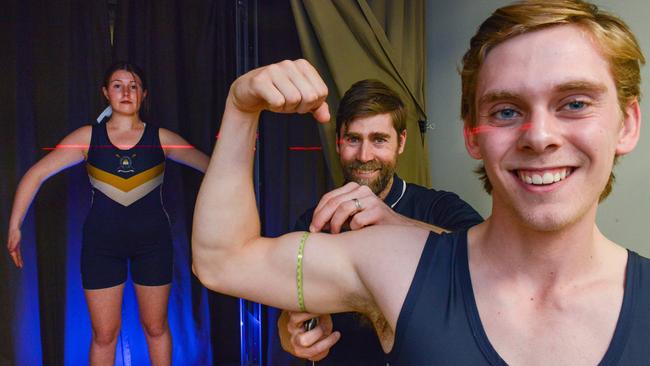How to spot our next sports star in just 35 seconds: UniSA reveals new talent scout as 3D body scan
Technology developed in Adelaide can tell you how well suited you are a sporting code within seconds ... but your local footy club will need to do plenty of fundraising if it wants one.

SA News
Don't miss out on the headlines from SA News. Followed categories will be added to My News.
- Where South Australia’s elite sporting coaches are teaching
- Latest subscriber-exclusive giveaways, specials and prizes
An Adelaide study is being hailed as a game-changer in the field of talent identification of young sporting stars at the school, community and club level.
Work by UniSA sports scientist Grant Tomkinson shows how data captured by a cost-effective whole-body scanner can provide vital intel into an individual’s physical propensity for particular codes, in just 35 seconds.
One of the main ways to select athletes for specific sports – think Usain Bolt, Ian Thorpe or Anna Meares – is to compare their body size and shape with the general population, he said.
But with a price tag of about $100,000, the hi-tech 3D devices used by major sports and training institutes are out of reach for most organisations.

In Prof Tomkinson’s study, a $7500, portable scanner was used to measure athletes’ shape and composition, comparing the results with X-rays, MRIs and manual tests involving bone calipers and girth tapes to test the reliability of the device.
Currently based in the US, he analysed the results taken from dozens of collegiate sportspeople, men and women.
“In a few seconds, a 3D body scan can measure the length of an arm and leg, the circumference of a thigh, or a body girth, as well as detect any asymmetries, such as scoliosis, or different leg lengths, which can affect the body’s musculature,” he said.
Colleague and post doctoral research fellow, Nathan Daniell, describes the study as “game-changing”.
“By showing the reliability of the lower-cost versions, it means the technology is no longer restricted to our elite institutions and potentially opens the door for it be used by sporting clubs and gyms … (and) rolling it out on a much wider level for talent identification,” Dr Daniell said.
“We know multidimensional measurements, such as segmental volumes and surface areas, are proving to be better predictors of performance than the more simple one dimensional ones.
“I would say this changes the game because it provides the potential for us to identify elite athletes sooner through measuring those volumes and surfaces which previously were just not feasible to do.
MORE NEWS
King: Crows taking plastic knife to a gun fight
Experts urge rethink on kids’ screen time caps
Who wants a church wedding? Young couples say ‘I don’t’
“For example, thoracic volume along with upper leg volume and surface area (are) proved to be strong predictors of rowing performance.”
Australian Institute of Sport performance services manager Julian Jones describes the information gleaned by a 3D scan as “a starting point”.
“It is a tool in your toolbox to assess what you have to work on ... you are always looking for a more efficient and effective way of collecting this sort of information,” he said.
“But high performance success outcomes for athletes is a multifactorial situation … sport will always throw up someone who isn’t within those (expected) realms but is just a great performer.
“Yes, being tall is an element (of a good basketball player) but it is not the only element, there are a lot more tall people in the world than there are good basketball players.
“You can have all the physical attributes in the world but if you can’t mentally apply yourself with the right drive, handle a certain amount of stress and anxiety on a consistent basis, you are not going to make it.”
